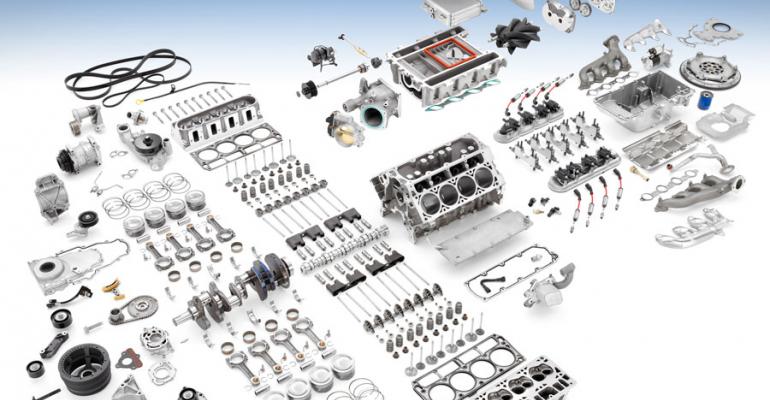ALTON, VA – Engineers make both hardware and software tweaks to General Motors’ supercharged LSA 6.2L V-8 engine to wring out more horsepower and torque from the venerable small-block architecture for its application in the ’12 Chevrolet Camaro ZL-1.
Compared with the LSA V-8 that powers the Cadillac CTS-V, the version in the Camaro ZL-1 makes an additional 24 hp for a peak SAE-rated 580 ponies at 6,000 rpm. Credit a more-efficient Eaton-sourced supercharger, a designed-from-scratch induction system and an active exhaust system.
“More horsepower, that was the end goal,” says Al Oppenheiser, chief engineer on the Chevy Camaro and its range-topping ZL-1 awaiting shipment to dealers.
Eaton’s sixth-generation design displaces 1.9L, as it does in the Cadillac, but the Camaro’s heat exchanger, or “brick,” was lengthened to improve air-flow volume and efficiency.
The bigger brick means more and cooler air is delivered to the cylinder heads, as much as 126° F (70° C) colder, maximizing the ZL-1’s performance potential.
“The supercharger loves the cold, so in the cooler temperatures, when the air particles aren’t so heavy, you can make big horsepower,” Oppenheiser tells WardsAuto during a testing of the ZL-1 here.
Maximum boost remains at 9.0 psi (0.62 bar), and a Roots-style 4-lobe rotor design delivers improved efficiency and is quieter, a key element to making the supercharger suitable for GM’s toney Cadillac brand.
GM engineers also entirely rebuilt the induction system between the two applications, relying heavily on computational fluid dynamics.
In addition to improved air flow through the supercharger housing, the ZL-1’s V-8 takes advantage of a lower-restriction air filter and dual inlet paths. The lower grille design also helps the induction system gulp more air. Overall air restriction was reduced 30% between the applications.
“Just carrying over the CTS-V engine, which we put in our first prototype car, we weren’t making the horsepower we wanted,” says Oppenheiser, whose team was tasked with trumping the 550 hp produced by the Ford Mustang Shelby GT500.
“So we went back to the drawing board, pulled out our packaging and got all the engineers together to design a new induction system.”
The ZL-1 also features an active exhaust system. Vacuum-controlled valves manipulate depth of the exhaust note roar, which makes for epic-sounding throttle blips. But when those valves open, they create a straight pipe from the catalyst to the rear tip.
“You could roll a golf ball all the way up,” Oppenheiser says. “Very simplistic, but we maximized horsepower input from the exhaust manifold.”
An electric power-steering system steals less engine power than a hydraulic one, and by tinkering with the spark timing engineers maximize combustion.
One of two transmissions puts the power to the pavement. A Tremec TR6060 6-speed manual transmission handles 30% more torque than in the Camaro SS, courtesy of a strengthened output shaft and an additional main shaft roller bearing. GM designed the gearbox’s shifter.
A Hydra-Matic 6L90 6-speed automatic transmission was designed with everyday driving in mind. GM believes take rates on the automatic could reach 50% of ZL-1 deliveries once hard-core enthusiasm for the Tremec settles down.
During normal driving, the automatic will launch the car from second gear, but in “sport” mode it will begin in first gear and hold all of the lower gears longer. Shifts also become more aggressive.
When drivers switch to “manual” mode using paddle shifters, engine-management software will not intervene at the red line, allowing for truer stick-shift performance. Upshifts are anticipated by the transmissions, shorting shift times.
Compared with other Camaros in the GM stable, the ZL-1 is 30% redesigned, Oppenheiser says. “I think we looked at everything with the exception of the suede headliner, and I’m trying to figure out a performance value for that now.”
GM says the changes combine to send the $55,000 ZL-1 from 0-60 mph (100 km/h) in 3.9 seconds and reach top speed of 184 mph (296 km/h).
The auto maker estimates models equipped with the manual transmission will achieve fuel economy of 14-16 mpg (16.7-14.6 L/100 km) city/highway and face a $1,300 gas- guzzler tax from the National Highway Traffic Safety Admin.
Models with the automatic will see 12-14 mpg (19.6-14.6 L/100 km) city/highway and $2,600 gas-guzzler tax.
In related news, GM spokesman Monte Doran says the ZL-1 engineering team is “close to validating a solution” to a quality problem that has held up delivery of the car from its Oshawa, ON, Canada, assembly plant to dealers for several weeks now.
The auto maker discovered a potential quality issue during its final assessment of the ZL-1 earlier this month. “I expect we will begin shipping cars in weeks rather than months,” Doran tells WardsAuto.
GM builds the LSA V-8 in Silao, Mexico.




